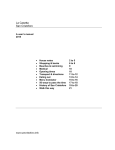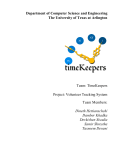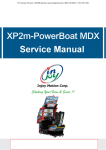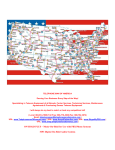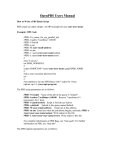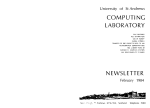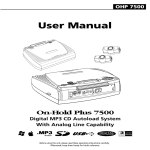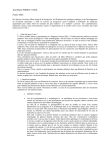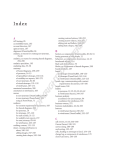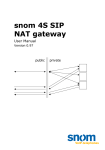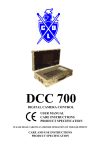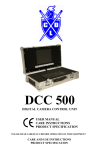Download IdeaFisher - American Marketing Association
Transcript
. SOFTWARE REVIEWS EDITOR—TERRENCE V. O'BRIEN Marketing Department Chairman Northern Illinois University IdeaFisher IdeaFisher is a unique software program targeted to improving the creativity of individuals or small groups. As part of this review, I talked to users and developers, and they are an enthusiastic lot. Applications range from naming new products to generating new product concepts to identifying related topics that should be considered. In using IdeaFisher first-hand, I was impressed with how powerful and fluid this software is; it feels as though the software ranges with you, exploring in all directions. We are pleased to have a guest reviewer, and his evaluation follows. Reviewer: Rajendra S. Sisodia George Mason University Rating: 5 of 5 (excellent) Most computer users (even those regarded by colleagues as power users) tend to employ the machines to make themselves more efficient at doing things that could be accomplished manually. We rarely use computers in ways that enhance our effectiveness in such efforts as taking the company in new directions, launching better products, or being more creative. Computers are capable of helping in those areas, but many people are reluctant to explore such uses. Moreover, few software packages provide such functionality. That situation may be changing. Alan Kay, a visionary in the computer field and a Fellow at Apple, made the following observation about computer software: In a computer the same notation can specify actuarial tables or bring new worlds to life. . . . architecture dominates material. To understand clay is not to understand the pot. Terrence V. O'Brien 52 Fortunately, our ability to fashion interesting pots and other objects out of the metaphorical clay of computers is getting better. One of the more intriguing developments in that direction is an application software category that can best be described as brainstorming or intelligence extension software. Such software makes use of the computer's innate strengths in being able to remember, relate, and organize enormous amounts of information accurately and instantly. The computer thus becomes akin to an idiot savant—an extremely brainy, well-read, tireless, but essentially naive assistant who MARKETING RESEARCH, DECEMBER 1991 can be used as a sounding board and a partner in free-associating and in prompting us to think of all the possible dimensions of a problem. The best example of the new class of software is IdeaFisher, a product that has been 12 years and $3.5 million in the making. It started as an idea that Marshall D. Fisher, its creator, had been toying with since the mid-1960s—whether it is possible to create a database of ideas and associations that could trigger unusual connections in the user's mind. Fisher is an eclectic individual who at various times in his career has been a farmer, journalist, taxidermist, vocalist, stand-up comedian (he once appeared on The Ed Sullivan Show), real estate salesman, and cofounder of Century 21 Real Estate. In 1977, he retired to Hawaii and began tinkering with the idea of creating a product that would come up with the kinds of surprising associations and ad-libs that stand-up comedians use to get laughs. The project evolved into something much larger and the result is a package that contains more than 61,000 idea words organized into 28 major categories and 387 topical categories. Those yield the cross-referencing power of more than 705,000 idea-associations and a near-infinite number of secondary associations. The program was launched in April 1989 for both the IBM-compatible and Macintosh platforms. It was recognized as a unique and impressive achievement; PC Magazine named it "Best of 1989" and commented, "If you buy a copy for yourself, chances are you won't be telling your co-workers about it." The package was also given the PC Week Analysts' Choice Award in March 1991. A study at the University of Hawaii found that students who claimed to be drained of ideas showed a 90% increase in creativity after using IdeaFisher. Regular users include Tom Peters, Arthur C. Clarke, and the Disney Corporation, along with a long list of other companies and individuals such as authors, copywriters, speech writers, sermon writers, and comedians. What Is IdeaFisher? About 50% of Fortune 500 companies have in-house creativity departments, reflecting the growing commercial importance of ingenuity and inventiveness. However, creativity is valuable throughout the organization, and especially in marketing and advertising. It is therefore important that creativity be actively decentralized rather than assigned to a separate department. The creative process is usually serendipitous; how^ever, given its importance to a company's success, companies should explore how effective various tools can be in forcing or jumpstarting the process. Companies have used the technique of brainstorming for that purpose, but its possibilities are limited by the background and mental stamina of the participants. Further, such sessions are difficult to organize on a regular basis. Billed as the first associative lexicon of the English language, IdeaFisher is a catalytic tool to stimulate the creative process. The program's developers emphasize what they call "the new 3 R's"—recording, retrieving, and reassociating (or SOFTWARE REVIEWS 53 recombining). By incorporating an understanding of the way in which associative memory works, IdeaFisher is able to remind the user of associations that might have remained buried in the subconscious mind. Give IdeaFisher a thought (encapsuled in a word or phrase) and it will instantly give hundreds or thousands of related thoughts, organized in a number of ways. Just as a thesaurus gives a word's related meanings, IdeaFisher gives related associations. Those in turn can trigger other associations, leading the user in an almost unlimited number of possible directions. In a matter of minutes, it can yield hundreds of thoughts that could have taken dozens of people many days to produce. Those thoughts by themselves are meaningless but, when combined with the agile mind of the user, can lead to useful new ideas. IdeaFisher thus has great potential as a memory jogger for creative people; it reminds you of what you already know. The product is not smart in the sense of having any cognitive abilities; it remembers everything but understands nothing beyond the interconnectedness of ideas. In that sense, it is a hypertext product, though it is not billed as such. The program deliberately strives to be logic-free, leaving that aspect of thinking entirely to the user. How It Works IdeaFisher has three main components—the Question Bank (QBank), the IdeaBank, and Notepads. The QBank An important part of creative problem solving is to make sure all important aspects of the problem are considered. Users may think they know what the right questions are, but a quick glance through the QBank will change their minds. Reflecting the developers' expertise in business planning, the questions are exhaustive and insightful, and answering them can lead to valuable perspectives. QBank contains more than 3000 questions grouped according to the nature of the problem. The three divisions of questions a/e Orient-Clarify, Modify, and Evaluate. Orient-Clarify questions are intended to help identify the aims and elements of the task and to clarify objectives; they indude such categories as "Developing a Story or Script" and "Developing a Marketing Strategy or Promotional Campaign." Modify questions are useful for altering or adapting potential ideas or solutions. Using them can enable you to transform an idea in interesting ways. They comprise more than two dozen categories, such as "Combining-Synthesizing," "Opposite-Reversals," and "Mechanization-AutomationPower." Evaluate questions are appropriate at the beginning, middle, and end points of a project. Categories include "Taking Stock," "Costs-Benefits-Success-Failure-Risk," and "Human Concerns-Social Concerns." As you answer the questions appropriate to your purpose, your responses are noted in the Question Notepad. At the end of that process, you apply the Key Concepts filter to your answers; it is a simple algorithm that first discards noise words 54 MARKETING RESEARCH, DECEMBER 1991 such as "the" and "very," and then rank orders concepts in terms of the frequency with which they came up. You can then choose certain concepts to explore via the IdeaBank. The IdeaBank This is really the heart of the program—the part that is most likely to result in an "Ah-ha!" experience. Working with the concepts you have identified in QBank, or starting fresh with a concept you want to explore, you enter the word or phrase that best represents your thought. If you do not have a starting point, go to Major Categories and choose an appropriate category. You immediately get back a list of Topical Categories containing that concept. Pick the one that seems most promising. You then get a list of Section Titles comprising hundreds of examples, descriptors, and abstractions related to the concept. Any of them can serve as a springboard to launch you in another direction. IdeaBank and QBank can be used separately. It is more fruitful, though, to use them in a back-and-forth process in which word associations trigger answers to the questions and questions prompt the user to plug in new associations. At any time, you can mark items that trigger thoughts in your mind and copy them to the Idea Notepad. There you can add your own thoughts and expansions as they occur. When you are finished, the Idea Notepad (as well as the Question Notepad) can be printed or exported as an ASCII file to a word processor. The Compare Feature This interesting feature enables the user to explore all the common associations of two concepts. For example, a Hollywood scriptwriter came up with a novel idea for a movie titled Rodeo Vampires in Love. A Compare on "cowboys" and "vampires" yields similarities that can be woven into the script—both cowboys and vampires are legendary figures, have strong romantic images associated with them, share a fear of growing old, and are on a quest for immortality. Personal Librarian You can add your own unique questions and associations to IdeaFisher by using this feature. The next time you use the program, those associations and questions will be included. Marketing Application Reading the user documentation, you get the feeling that the package was designed primarily with marketing and advertising applications in mind. Indeed, the first 10 uses mentioned are: —develop a new product or service, —name a new product or company, —position a product, —develop a marketing strategy or promotional campaign, —plan an advertisement, —create a slogan, —modify or revitalize a product or service, —keep focus groups on target, —design an object, and —design a procedure. SOFTWARE REVIEWS 55 The list is fairly self-explanatory. The package can be used by individuals as well as groups; in the latter mode, it serves the purpose of automating the note-taking process. With one user working the machine and projecting the screen for others to see, IdeaFisher can elicit a large number of ideas from the group. For advertising agencies, the product is a treasury of American popular culture (it does include international aspects, but only those fairly familiar to Americans). Using it is akin to tapping into the collective mind of consumers. Several marketing examples are presented in the user manual; they include coming up with new product ideas (resulting in air-filled car seats and insect-repellant socks for summer use), brand names, and advertising slogans. Let me provide several illustrations. When I started with the term "idiot savant" to describe IdeaFisher, several associations resulted, such as inductive reasoning, left-brain activity, linear thinking, well-informed, central nervous system, and light bulb over a person's head, as well as miscellaneous thoughts such as: —If you're so smart, why aren't you rich? —It's the thought that counts. —One idea leads to another. —Out of sight, out of mind. —Two heads are better than one. —With MY brain and YOUR good looks. For a humorous article called "The Cranky Tourist," a Compare on "cranky" and "tourist" yielded the following list: flee to avoid punishment, slip through a dragnet, tourist trap, whine, airplane food, bad art, modern art. Grumpy, know-it-all, nitpicker, sourpuss, sacred cow, damn with faint praise, sound like a broken record, seif-flagellation, holierthan-thou, and Better Business Bureau, as well as phrases such as "Everybody complains about the weather . . .;" "If you can't say something nice . . . ;" "Lighten up!;" "Waiter, there's a fly in my soup." You get the idea. Setup And Other Details Installing the program is simple, though it takes a while. The program comes on 18 disks and takes about 7MB of hard disk space. You might find that excessive until you realize it used to take about 25MB! Fortunately, compression techniques have made the program's size manageable and have speeded access. Despite its size, the program is quick and responsive. The main determinant of speed is hard disk access time. The program works well on even an XT-compatible machine without any noticeable loss of performance; only the Compare feature may show a difference of a few seconds across machines. A mouse is recommended, but I really did not find it necessary. The interface is rather intimidating at first, but soon becomes familiar. The cascading windows are not very intuitively designed, and navigating around them can be disorienting initially. The help facility and function key assignments are not entirely logical. For example, the ESC key doesn't "back you out" of the windows (the F3 key does that), but gets you into the bar menu on top. This is a "Paradox" convention that is unfamiliar to most users. 56 MARKETING RESEARCH, DECEMBER 1991 You really do have to read the manual; this is not a plugand-play package. There is no substitute for time and practice. I assure you, however, that progress along the learning curve is very rapid and you will soon be up to speed. A network version was recently introduced. A Macintosh version has been available for some time, which is essentially identical to the DOS version 3.1 I tested. The company offers a 30-day money-back guarantee and unlimited toll-free customer support. Limitations An online tutorial would help users get up and running faster. Though an improved n:ianual has just been released, the documentation is still only adequate and doesn't do justice to the quality of the program. I hope third-party books will soon appear to improve that aspect. A more intuitive interface would make it easier to miove around between the windows. The help feature is somewhat limited in depth and not context-sensitive. A bar at the bottom of the screen with function key assignments would also be helpful. Conclusions Other than some difficulty of initial use, the package really does meet all the expectations one could reasonably have of it. It will constantly surprise you with what it "knows" and will undoubtedly make you more creative. You must be very careful to maintain a strong clarity of objectives while using it; otherwise you can soon find yourself far afield. By its very nature, the product is culture-specific. The company's own tests have shown only 50% of the connections to be valid in French and Japanese and 80% in German. In the future, we might see foreign language versions as well as an international English version. The company is also investigating a CD-ROM version, which may include photographic illustrations. Both IdeaBank and QBank are updated twice annually. In addition, the company is developing various plug-in modules on specialized topics. So far, a Strategic Planning module is available for $99; it contains more than 700 questions in two sections, one on the development of a strategic plan and the other on implementation. From aU indications, the company is customer-oriented and commands a loyal following. As evidence, the last upgrade was free to registered users, and unlimited free customer support is provided. The list price for IdeaFisher is $595. It is available directly from Fisher Idea Systems, 18881 Von Karman Avenue, Irvine, CA 92715 (800-289-4332), or from various retailers. • An Invitation If you would be interested in reviewing software for Marketing Research, please write or catt Terry O'Brien, 651 Normal Road, DeKalb, IL 60115; voice (815) 753-6222 or FAX (815) 753-6014. Reprint No. MR34107 SOFTWARE REVIEWS 37







